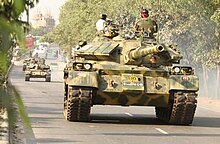| Bangladesh Rifles revolt | |||||||
|---|---|---|---|---|---|---|---|
 | |||||||
| |||||||
| Belligerents | |||||||
| Bangladesh Rifles (mutineers) | |||||||
| Commanders and leaders | |||||||
| Unknown | |||||||
| Strength | |||||||
| Unknown | 1,200 mutineers | ||||||
| Casualties and losses | |||||||
| 57 killed,[1] 6 missing[2] | 8 killed,[2] 200 captured[3] | ||||||
| 17 civilians killed[4] | |||||||
| ||
|---|---|---|
|
First Premiership (1996–2001) Opposition Leader (2001–2009) Second Premiership (2009–2024)
Elections Ministries National Projects Others Gallery: Picture, Sound, Video |
||
The Bangladesh Rifles revolt (also referred to as the Pilkhana tragedy/Pilkhana massacre) was a mutiny staged on 25 and 26 February 2009 in Dhaka by a section of the Bangladesh Rifles (BDR), a paramilitary force mainly tasked with guarding the borders of Bangladesh. The rebelling BDR soldiers took over the BDR headquarters in Pilkhana, killing BDR director-general Shakil Ahmed along with 56 other army officers and 17 civilians. They also fired on civilians, held many of their officers and their families hostage, vandalised property and looted valuables.[5] By the second day, unrest had spread to 12 other towns and cities.[6][7] The mutiny ended as the mutineers surrendered their arms and released the hostages[8] after a series of staged discussions and negotiations with the government.[9]
On 5 November 2013, Dhaka Metropolitan Sessions Court sentenced 152 people to death and 161 to life imprisonment; another 256 people received sentences between three and ten years for their involvement in the mutiny. The court also acquitted 277 people who had been charged. The trials have been condemned as unfair mass trials without timely access to lawyers and "seem designed to satisfy a desire for cruel revenge", as charged by Human Rights Watch, Amnesty International and the United Nations High Commission for Human Rights.[10][11]
- ^ "657 jailed for Peelkhana mutiny, 9 freed". bdnews24.com. 27 June 2011. Retrieved 27 November 2015.
- ^ a b Julfikar Ali Manik (3 March 2009). "6, not 72, army officers missing". The Daily Star. Archived from the original on 11 June 2015. Retrieved 6 November 2013.
- ^ Cite error: The named reference
bbc7914071was invoked but never defined (see the help page). - ^ Cite error: The named reference
nyt5Nov2013was invoked but never defined (see the help page). - ^ ""The Fear Never Leaves Me"". Human Rights Watch. 4 July 2012.
- ^ বিডিআর জওয়ানদের বিদ্রোহ নিহতের সংখ্যা ১৫ বলে দাবি * মহাপরিচালক শাকিল বেঁচে নেই * জিম্মি কর্মকর্তাদের পরিণতি অজানা [Rebellion of BDR jawans claims death toll at 15 * Director General Shakeel not alive * Fate of hostage officials unknown]. Prothom Alo (in Bengali). 26 February 2009. p. 1. Archived from the original on 27 February 2009. Retrieved 25 February 2009.
- ^ "Bangladesh guard mutiny 'spreads'". BBC News. 26 February 2009. Retrieved 23 April 2010.
- ^ "Bangladesh guard mutiny 'is over'". BBC News. 26 February 2009. Retrieved 5 January 2010.
- ^ অবশেষে আত্মসমর্পণ. Prothom Alo (in Bengali). 27 February 2009.
- ^ "Human Rights Watch Report on Bangladesh Rifles Mutiny Trial". Human Rights Watch. 4 July 2012. Retrieved 29 June 2014.
- ^ "UN's Pillay slams Bangladesh death sentences over mutiny". BBC News. 6 November 2013. Retrieved 7 November 2013.

